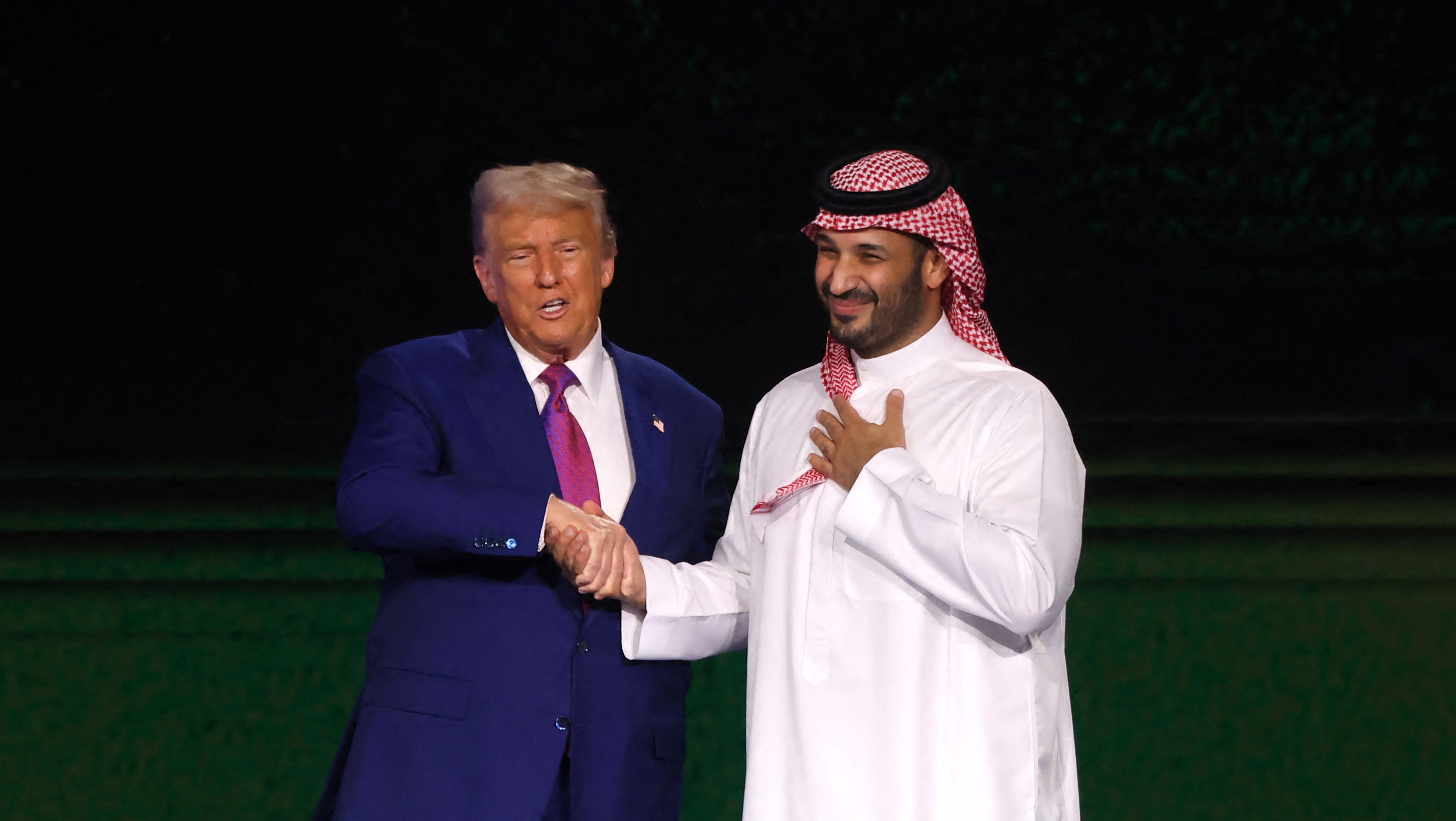Trump’s Support Reinforces MbS’s Hold on Power as Succession Nears
The US president’s public backing during his visit strengthens Mohammed bin Salman’s rule, silences rivals, and signals American support amid shifting Saudi power dynamics
The path to the Saudi throne appears increasingly clear for Crown Prince Mohammed bin Salman (MbS), following US President Donald Trump’s high-profile visit to Saudi Arabia in May 2025. Trump’s public praise for the crown prince, delivered during a major investment forum in Riyadh, reinforced MbS’s international stature and sent a strong message of US alignment with the Saudi heir.
At the Saudi-US Investment Forum, Trump called MbS “an incredible man” and “my friend,” celebrating his leadership and domestic reforms. He also announced a $600 billion Saudi investment commitment to the United States, spanning sectors such as defense, energy, and tech. Trump’s remarks drew applause when he expressed his wish that “Saudi Arabia … will soon be joining the Abraham Accords,” and he emphasized a renewed partnership by stating, “No one will be able to destabilize his rule.”
Prince Mohammed bin Salman has consolidated his rule, and there may now be no resistance to him domestically
Fahd al-Sunni, a Saudi political researcher based abroad, told The Media Line, “Prince Mohammed bin Salman has consolidated his rule, and there may now be no resistance to him domestically.” He added, “Even if US President Donald Trump hadn’t spoken well of him during his time in Saudi Arabia, Prince Mohammed bin Salman now has widespread international influence and is also fairly popular domestically.”
MbS, who will turn 40 in August, was not initially considered a leading candidate for crown prince a decade ago. Several of King Salman’s older sons held more prominent profiles at the time, including Prince Sultan bin Salman—the first Arab and Muslim astronaut, who flew on a NASA space shuttle mission in 1985—and Prince Abdulaziz bin Salman, who currently serves as Saudi Arabia’s energy minister. Both were bypassed in the line of succession when King Salman elevated his much younger son, Mohammed, to the deputy crown prince role in 2015.
Traditionally, Saudi succession followed a horizontal pattern: the throne passed from one son of the kingdom’s founder, King Abdulaziz Al Saud (1875–1953), to another, rather than from father to son. This model, based on seniority and consensus among senior princes, helped preserve family unity and stability for decades. But as that first generation aged, pressure mounted to shift to the next generation. When MbS was named crown prince in 2017, it marked a dramatic break with this tradition, ushering in vertical, father-to-son succession for the first time since the founding of the modern Saudi state.
At the time, senior royals like Prince Ahmed bin Abdulaziz—King Salman’s younger brother—and Prince Mohammed bin Nayef, the then–interior minister and nephew of the king, were viewed as more likely successors. In April 2015, Mohammed bin Nayef was appointed crown prince by King Salman with the Allegiance Council’s approval, while MbS was named deputy crown prince.
Give the gift of hope
We practice what we preach:
accurate, fearless journalism. But we can't do it alone.
- On the ground in Gaza, Syria, Israel, Egypt, Pakistan, and more
- Our program trained more than 100 journalists
- Calling out fake news and reporting real facts
- On the ground in Gaza, Syria, Israel, Egypt, Pakistan, and more
- Our program trained more than 100 journalists
- Calling out fake news and reporting real facts
Join us.
Support The Media Line. Save democracy.
In June 2017, King Salman abruptly removed Mohammed bin Nayef from all official roles and elevated his son to crown prince. Reports emerged that Mohammed bin Nayef had become dependent on painkillers following a 2009 assassination attempt, and that concerns about his health and influence had been circulating within the palace. There were also unverified claims—widely circulated in Gulf media and Western press—alleging Muslim Brotherhood infiltration within the Ministry of Interior during his tenure. None of these accusations were publicly substantiated by the Saudi government.
Following his removal, Mohammed bin Nayef was reportedly placed under house arrest and barred from international travel, though Saudi authorities never confirmed these restrictions. He has not appeared in public since.
Another rival, Prince Miteb bin Abdullah, son of the late King Abdullah and former minister of the Saudi National Guard, was also dismissed in late 2017. His removal came during a sweeping anti-corruption campaign that saw dozens of royals, ministers, and businessmen detained at the Ritz-Carlton hotel in Riyadh. While the official justification was corruption, critics argued that the campaign also functioned as a political purge designed to neutralize powerful alternative centers of influence within the royal family.
“There was fear of some princes like Ahmed bin Abdulaziz, Prince Mohammed bin Nayef, and Prince Miteb bin Abdullah,” said al-Sunni, “but now they are all gone and have no influence on Saudi politics. Their aides and loyalists have been dismissed and removed over the past 10 years.”
King Salman, now 89 years old, has made only limited public appearances in recent years. His last public video with speech was during the opening of the Shura Council session on October 9, 2022. Since then, he has appeared only in silent footage and photographs, and has not met personally with visiting foreign leaders.
Opposition figure Ali al-Asiri told The Media Line that Mohammed bin Salman has centralized power across all branches of government. “For several years, no government position has been appointed unless they are loyal to Prince Mohammed bin Salman, and all ministers now owe their loyalty to him,” he said. “Most of the influential figures in Saudi politics have been eliminated—whether princes, businessmen, or others who once had significant sway.”
He added, “The Saudi people may have been optimistic at the beginning of King Salman’s reign, and many good decisions were made for the people, but what happened afterwards caused internal discontent, and there are many who could exploit it to change the regime.”
Most of the influential figures in Saudi politics have been eliminated—whether princes, businessmen, or others who once had significant sway
While al-Asiri cited internal repression, he said MbS’s main challenge now lies outside the kingdom. “Perhaps Mohammed bin Salman’s problem now lies in the ongoing Gulf power struggle,” he said. “He sometimes clashes with the leadership in the UAE, which has a strong influence. He previously clashed with the emir of Qatar, and now he has many economic clashes. But all of them were resolved through the visit of US President Donald Trump, which sent a direct message that Prince Mohammed bin Salman has a strong alliance with the United States and no one will be able to destabilize his rule.”
Prince Mohammed bin Salman has a strong alliance with the United States and no one will be able to destabilize his rule
Saudi journalist Munther al-Askari, by contrast, rejected talk of instability. “Things are different in Saudi Arabia. It is a politically stable country, and everyone works for the good of the state,” he said. “The Allegiance Council ensures the stability of the government, and even the issue of who will be the next crown prince will be resolved. There are many good candidates, and we are witnessing a new era for the descendants of King Abdulaziz, initiated by Prince Mohammed bin Salman.”
He noted that it’s not unusual for Saudi crown princes to assume day-to-day leadership while the king is elderly or unwell. “Previously, King Abdullah assumed leadership while he was crown prince, as King Fahd suffered from several ailments. This happened again with King Salman, who assumed leadership while King Abdullah was in declining health. Prince Mohammed bin Salman assuming leadership while he is crown prince is not surprising.”



